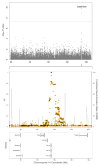Mosaic loss of chromosome Y is associated with common variation near TCL1A
- PMID: 27064253
- PMCID: PMC4848121
- DOI: 10.1038/ng.3545
Mosaic loss of chromosome Y is associated with common variation near TCL1A
Abstract
Mosaic loss of chromosome Y (mLOY) leading to gonosomal XY/XO commonly occurs during aging, particularly in smokers. We investigated whether mLOY was associated with non-hematological cancer in three prospective cohorts (8,679 cancer cases and 5,110 cancer-free controls) and genetic susceptibility to mLOY. Overall, mLOY was observed in 7% of men, and its prevalence increased with age (per-year odds ratio (OR) = 1.13, 95% confidence interval (CI) = 1.12-1.15; P < 2 × 10(-16)), reaching 18.7% among men over 80 years old. mLOY was associated with current smoking (OR = 2.35, 95% CI = 1.82-3.03; P = 5.55 × 10(-11)), but the association weakened with years after cessation. mLOY was not consistently associated with overall or specific cancer risk (for example, bladder, lung or prostate cancer) nor with cancer survival after diagnosis (multivariate-adjusted hazard ratio = 0.87, 95% CI = 0.73-1.04; P = 0.12). In a genome-wide association study, we observed the first example of a common susceptibility locus for genetic mosaicism, specifically mLOY, which maps to TCL1A at 14q32.13, marked by rs2887399 (OR = 1.55, 95% CI = 1.36-1.78; P = 1.37 × 10(-10)).
Conflict of interest statement
The authors declare no relevant conflicts of interest.
Figures




Comment in
-
Mosaic loss of chromosome Y in leukocytes matters.Nat Genet. 2019 Jan;51(1):4-7. doi: 10.1038/s41588-018-0267-9. Nat Genet. 2019. PMID: 30374072 No abstract available.
-
Reply to 'Mosaic loss of chromosome Y in leukocytes matters'.Nat Genet. 2019 Jan;51(1):7-9. doi: 10.1038/s41588-018-0310-x. Nat Genet. 2019. PMID: 30514911 Free PMC article. No abstract available.
References
-
- Pierre RV, Hoagland HC. Age-associated aneuploidy: loss of Y chromosome from human bone marrow cells with aging. Cancer. 1972;30:889–94. - PubMed
-
- Loss of the Y chromosome from normal and neoplastic bone marrows. United Kingdom Cancer Cytogenetics Group (UKCCG) Genes Chromosomes Cancer. 1992;5:83–8. - PubMed
-
- Jacobs PA, Brunton M, Court Brown WM, Doll R, Goldstein H. Change of human chromosome count distribution with age: evidence for a sex differences. Nature. 1963;197:1080–1. - PubMed
-
- Abeliovich D, Yehuda O, Ben-Neriah S, Or R. Loss of Y chromosome. An age-related event or a cytogenetic marker of a malignant clone? Cancer Genet Cytogenet. 1994;76:70–1. - PubMed
Publication types
MeSH terms
Substances
Grants and funding
LinkOut - more resources
Full Text Sources
Other Literature Sources

